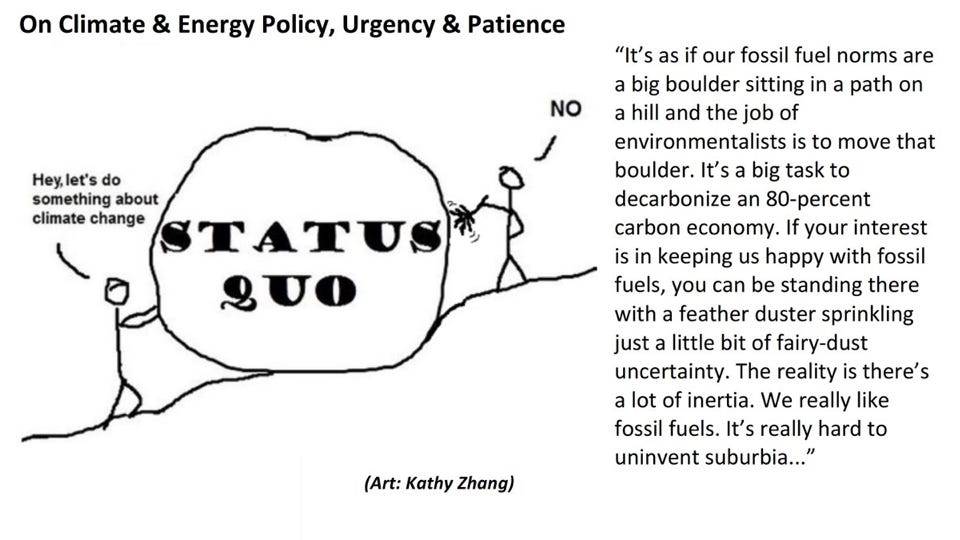A Professional Climate-Policy Pugilist and a Journalist Meet in a Podcast on Messaging
Narrative analyst and coach Randy Olson hosted onetime Limbaugh/Inhofe staffer Marc Morano and me in a climate communication conversation.
With environmental campaigners on the ropes facing President Trump’s climate-policy demolition derby, the science-communication trainer Randy Olson recently invited me onto his ABT Agenda podcast to provide some counterpoint to climate-policy antagonist Marc Morano, who has been exultant of late seeing his life’s work aimed at sustaining fossil fuel dominance come to fruition under Trump 2.0.
Here was Morano recently on Fox News proclaiming enviros should be cheering Trump for saving birds and whales by killing support for wind power projects. (If only it was that simple.)
We debated about a heap of things, and agreed on a few, and you really should take time out to hear the full episode (or scan the rough transcript here).
Here’s Randy’s intro blurb:
18 years ago, I interviewed climate skeptic Marc Morano for my movie, “Sizzle: A Global Warming Comedy.” I was impressed with his understanding the medium of film and television. He knew that ENTERTAINMENT is king. Almost no one watches films and television to be educated. They watch to be entertained. Which means anyone who is entertaining has a communications advantage. This has been the case with the current president. It is also the case with Marc Morano, as he told us.
Fossil fans have it easy
I talked, among other things, about how easy it has been for fossil fuelers and their allies to maintain the status quo. You may recall this cartoon by Kathy Zhang building on one of my frequent admonitions to those who try to convince you a better story from climate campaigners will turn the tide:
I also brought up the weaknesses of news media, including those I’ve worked for, in grappling with the influence of the fossil fuel industry - noting how an oil ad was placed right next to my very-first New York Times contribution, an op-ed on a wider implication of the Kuwait oil-well fires during the Persian Gulf War. (Or should I say Arabian Gulf now..?)
My first article related to climate and energy in the New York Times was an op-ed in the early days of the the Persian Gulf War, before I was on the staff. It's in like 1991. And right next to it, on the op-ed page of The New York Times, I was writing an article about the Kuwait fires and maybe if all the oil burned up, we wouldn't be so interested in the Middle East. Right next to it was an ExxonMobil ad - on the op-ed page. And that was part of a significant strategy by communications professionals working for these big companies to to influence opinion. They innovated the idea of buying ad space on the New York Times opinion page. And by the way, when my piece first ran, I didn't even notice it. It was like wallpaper, you know. And that's a big part of the campaigning, you know, for fossil fuels.
So narratives matter, but these subtle strategies matter even more, to my mind, particularly given how hard it is to move a well settled “boulder” like reliance on fossil fuels.
For lots more on the public relation strategy you see in that ope-ed advertisement, listen to and read everything the great audio journalist Amy Westervelt has produced on Herb Schmertz, the legendary p.r. guy behind what he called “op ads.” This piece in The Nation is a good start: Why Are ‘The New York Times’ and ‘The Washington Post’ Producing Ads for Big Oil? And listen to her Drilled podcast episodes on Schmertz. Here’s part 1:
Here’s more from Randy Olson on how Trump has dominated the narrative wars:
Caught in the Trump & Musk Flood Zone? Narrative Analyst Randy Olson Has Some Advice
I’ll wager that most of you have already heard or read Ezra Klein’s powerful audio “Don’t Believe Him” manifesto examining Trump’s take on Steve Bannon’s longstanding “flood the zone” strategy designed to overwhelm media and institutional capacity to convey and challenge his unfolding demolition derby presidency.









